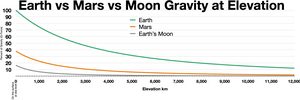
Back جاذبية المريخ Arabic Gravetat de Mart Catalan Gravedad de Marte Spanish گرانش مریخ Persian Gravidade de Marte Portuguese

The gravity of Mars is a natural phenomenon, due to the law of gravity, or gravitation, by which all things with mass around the planet Mars are brought towards it. It is weaker than Earth's gravity due to the planet's smaller mass. The average gravitational acceleration on Mars is 3.72076 m/s2 (about 38% of the gravity of Earth) and it varies.[1]
In general, topography-controlled isostasy drives the short wavelength free-air gravity anomalies.[2] At the same time, convective flow and finite strength of the mantle lead to long-wavelength planetary-scale free-air gravity anomalies over the entire planet.[3][4] Variation in crustal thickness, magmatic and volcanic activities, impact-induced Moho-uplift, seasonal variation of polar ice caps, atmospheric mass variation and variation of porosity of the crust could also correlate to the lateral variations.[5][6][7][8][9]
Over the years models consisting of an increasing but limited number of spherical harmonics have been produced. Maps produced have included free-air gravity anomaly, Bouguer gravity anomaly, and crustal thickness. In some areas of Mars there is a correlation between gravity anomalies and topography. Given the known topography, higher resolution gravity field can be inferred. Tidal deformation of Mars by the Sun or Phobos can be measured by its gravity. This reveals how stiff the interior is, and shows that the core is partially liquid. The study of surface gravity of Mars can therefore yield information about different features and provide beneficial information for future Mars landings.
- ^ Hirt, C.; Claessens, S.J.; Kuhn, M.; Featherstone, W.E. (2012). "Kilometer-resolution gravity field of Mars: MGM2011". Planetary and Space Science. 67 (1): 147–154. Bibcode:2012P&SS...67..147H. doi:10.1016/j.pss.2012.02.006. hdl:20.500.11937/32270.
- ^ Watts, A. B.; Bodine, J. H.; Ribe, N. M. (1980-02-07). "Observations of flexure and the geological evolution of the Pacific Ocean basin". Nature. 283 (5747): 532–537. Bibcode:1980Natur.283..532W. doi:10.1038/283532a0. ISSN 1476-4687. S2CID 4333255.
- ^ Cite error: The named reference
:21was invoked but never defined (see the help page). - ^ Cite error: The named reference
:20was invoked but never defined (see the help page). - ^ Cite error: The named reference
:0was invoked but never defined (see the help page). - ^ Cite error: The named reference
:18was invoked but never defined (see the help page). - ^ Cite error: The named reference
:14was invoked but never defined (see the help page). - ^ Cite error: The named reference
:5was invoked but never defined (see the help page). - ^ Cite error: The named reference
:19was invoked but never defined (see the help page).